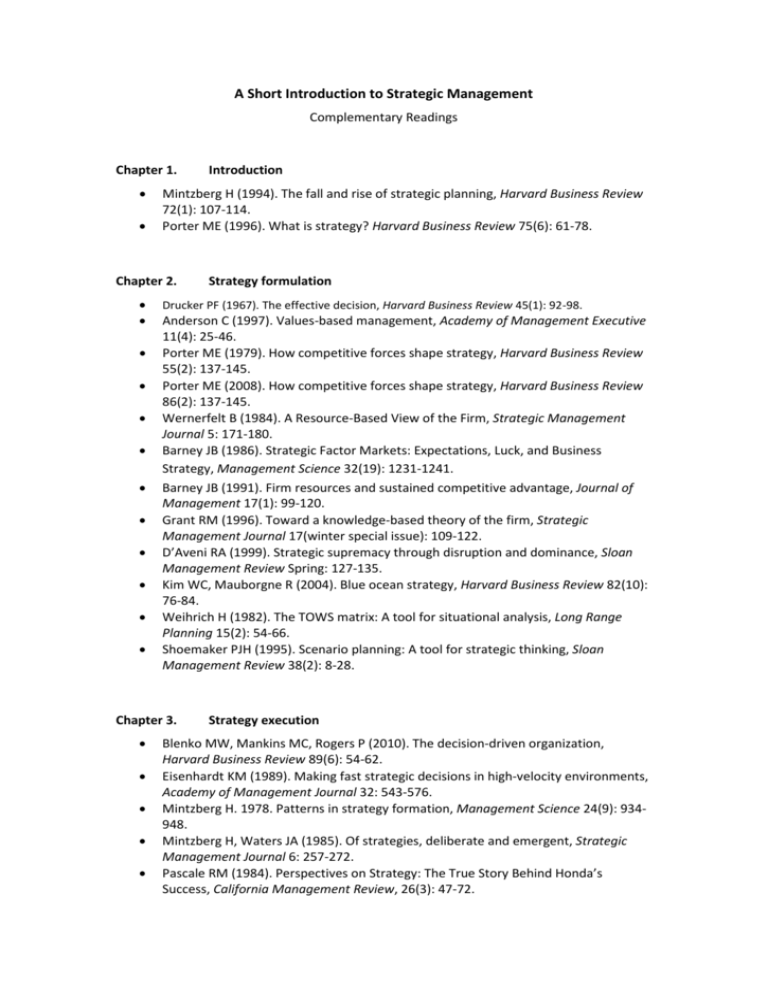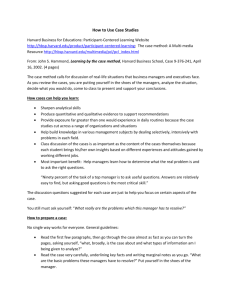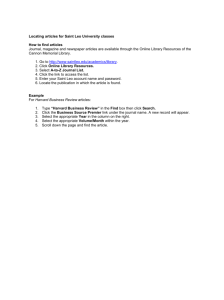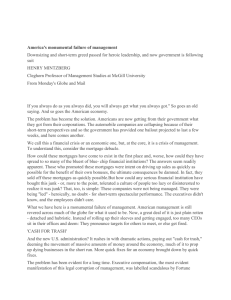Complementary Readings - Cambridge University Press
advertisement

A Short Introduction to Strategic Management Complementary Readings Chapter 1. • • Mintzberg H (1994). The fall and rise of strategic planning, Harvard Business Review 72(1): 107-114. Porter ME (1996). What is strategy? Harvard Business Review 75(6): 61-78. Chapter 2. • • • • • • • • • • • • • • • • Strategy formulation Drucker PF (1967). The effective decision, Harvard Business Review 45(1): 92-98. Anderson C (1997). Values-based management, Academy of Management Executive 11(4): 25-46. Porter ME (1979). How competitive forces shape strategy, Harvard Business Review 55(2): 137-145. Porter ME (2008). How competitive forces shape strategy, Harvard Business Review 86(2): 137-145. Wernerfelt B (1984). A Resource-Based View of the Firm, Strategic Management Journal 5: 171-180. Barney JB (1986). Strategic Factor Markets: Expectations, Luck, and Business Strategy, Management Science 32(19): 1231-1241. Barney JB (1991). Firm resources and sustained competitive advantage, Journal of Management 17(1): 99-120. Grant RM (1996). Toward a knowledge-based theory of the firm, Strategic Management Journal 17(winter special issue): 109-122. D’Aveni RA (1999). Strategic supremacy through disruption and dominance, Sloan Management Review Spring: 127-135. Kim WC, Mauborgne R (2004). Blue ocean strategy, Harvard Business Review 82(10): 76-84. Weihrich H (1982). The TOWS matrix: A tool for situational analysis, Long Range Planning 15(2): 54-66. Shoemaker PJH (1995). Scenario planning: A tool for strategic thinking, Sloan Management Review 38(2): 8-28. Chapter 3. • Introduction Strategy execution Blenko MW, Mankins MC, Rogers P (2010). The decision-driven organization, Harvard Business Review 89(6): 54-62. Eisenhardt KM (1989). Making fast strategic decisions in high-velocity environments, Academy of Management Journal 32: 543-576. Mintzberg H. 1978. Patterns in strategy formation, Management Science 24(9): 934948. Mintzberg H, Waters JA (1985). Of strategies, deliberate and emergent, Strategic Management Journal 6: 257-272. Pascale RM (1984). Perspectives on Strategy: The True Story Behind Honda’s Success, California Management Review, 26(3): 47-72. • • • • • • Pascale RM (1996). Reflections on Honda, California Management Review, 38(4): 112-117. Quinn JB (1978). Strategic change: “logical incrementalism”, Sloan Management Review 20(1): 7-21. Bettis RA, Hitt MA (1995). The new competitive landscape, Strategic Management Journal 16 (Summer – special issue): 7-19. Courtney H, Kirkland J, Viguerie P (1997). Strategy under uncertainty, Harvard Business Review 75(6): 67-79. Leuhrman T (1998). Strategy as a portfolio of real options, Harvard Business Review 76(5): 89-99. Miller KD, Waller HG (2003). Scenarios, real options, and integrated risk management, Long Range Planning 36: 93-107. Chapter 4. • • • • • • • Andersen TJ (2004). Integrating decentralized strategy making and centralized planning processes in dynamic environments, Journal of Management Studies 41(8): 1271-1299. Andersen TJ (2010). Combining central planning and decentralization to enhance effective risk management outcomes, Risk Management 12(2). Burgelman RA, Grove AS (1996). Strategic dissonance, California Management Review 38(2): 8-28. Bower JL, Gilbert CG (2007). How managers’ everyday decisions create or destroy your company’s strategy, Harvard Business Review 85(2): 72-79. Birkenshaw J, Gibson C (2004). Building ambidexterity into an organization, Sloan Management Review 45(4): 47-55. Mintzberg H (1976). Planning on the left side and managing on the right. Harvard Business Review 54(4): 49-58. Nonaka I (1988). Toward middle-up-down management: accelerating information creation, Sloan Management Review 29: 9-18. Chapter 5. • • • • • • • Integrative strategy making Corporate multinational strategy Prahalad CK, Hamel G (1990). The core competence of the corporation, Harvard Business Review 68(3): 79-91. Bettis RA, Prahalad CK (1995). The dominant logic: Retrospective and extension, Strategic Management Journal 16(1): 5-14. Collis DJ, Montgomery CA (1998). Creating corporate advantage, Harvard Business Review 76(3): 70-83. Roll R (1986). The hubris hypothesis of corporate takeovers, Journal of Business 59(2): 197-216. Goold M, Campbell A (1998). Desparately seeking synergy, Harvard Business Review 76(5): 131-143. Porter ME (1987). From competitive advantage to corporate strategy, Harvard Business Review 65(3): 43–59. Eisenhardt KM, Brown SL (1999). Patching: Restitching business portfolios in dynamic markets, Harvard Business Review 77(3):72-82. • • • • Karim S, Mitchell W (2004). Innovating through acquisition and internal development: A quarter-century of boundary evolution at Johnson & Johnson, Long Range Planning 37: 525-547. Doz YL, Bartlett CA, Prahalad CK (1981). Global competitive pressures and host country demands: Managing the tensions in MNCs, California Management Review 23(3): 63-74. Kogut B (1985). Designing global strategies: Profiting from operational flexibility, Sloan Management Review Fall: 27–38. Prahalad CK, Doz YL (1987). Mapping the characteristics of business Chapter 2 in The Multinational Mission: Balancing Local Demands and Global Vision. Free Press, New York: 13-37. Chapter 6. • • • • • • • • Strategic leadership Mintzberg H (1975). The manager’s job: Folklore and fact, Harvard Business Review 53(4): 49-61. Goold M, Campbell A (1998). Desperately seeking synergy, Harvard Business Review 76(5): 131-143. Campbell A, Whitehead J, Finkelstein S (2009). Why good leaders make bad decisions, Harvard Business Review 87(2): 60-66. Gavetti G, Rivkin JW (2005). How strategists really think: Tapping the power of analogy, Harvard Business Review 83(4): 54-63. Montgomery CA (2008). Putting leadership back into strategy, Harvard Business Review 86(1): 54-60. Campbell A, Whitehead J, Finkelstein S (2009). Why good leaders make bad decisions, Harvard Business Review 87(2): 60-66. Hamel G (2009). Moon shots for management, Harvard Business Review 87(2): 9198. Rumelt R (2011). The perils of bad strategy, McKinsey Quarterly (1): 30-39.





